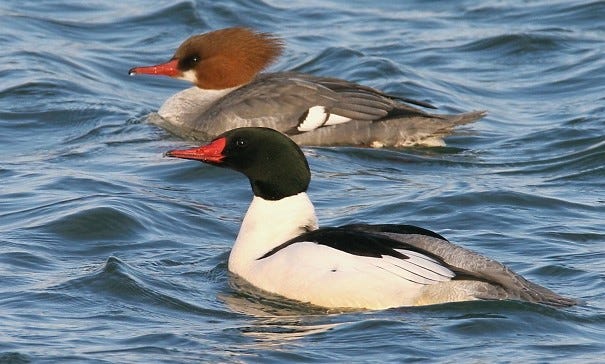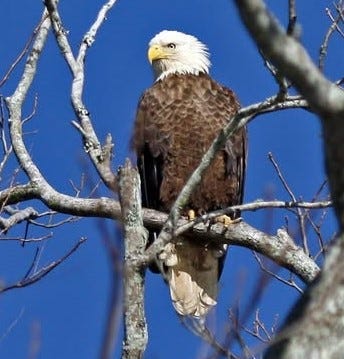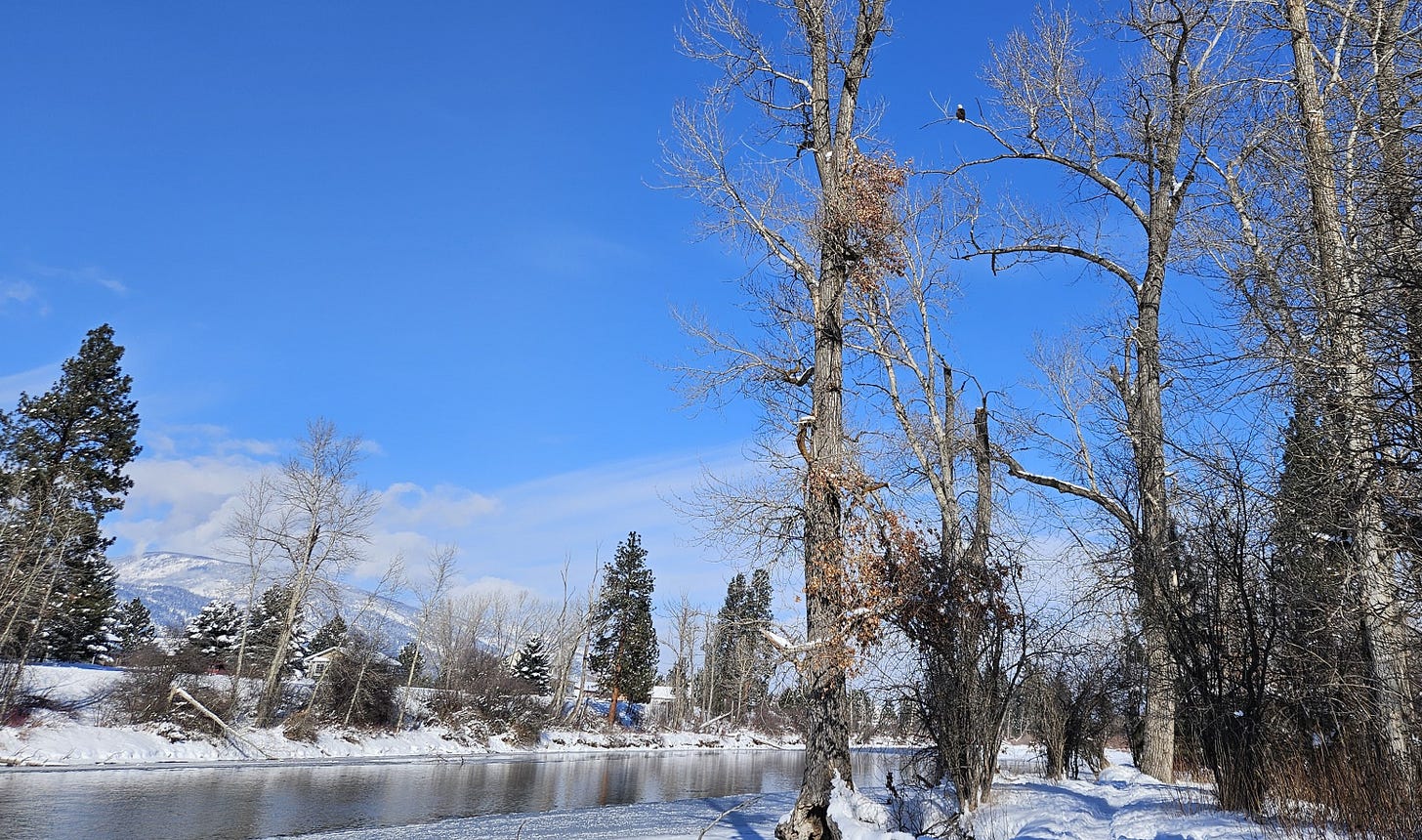Still here
Two days after the Superbowl, I drove the 25 minutes into town to grocery shop and stopped along the way to walk in my local river park. Bundled against the cold, I walked in silence under a brilliant blue sky. My two border collies bounded ahead of me then dropped to the ground, waiting for me to kick the pinecones they’d laid in my path. Steps muffled by the snow, I passed under wind-thrashed cottonwoods and scattered pines, then pushed past an encroaching alder thicket. Not a sound met my ears.
No chickadee calls enlivened the quiet. No nuthatch chattering drew my eyes to the tree trunks. No flicker voiced its sharp clear! from the overhead tangle of cottonwood branches. As I walked, the silence seemed to grow louder. And it disturbed me more and more. If I’d been walking on a similar day thirty years earlier, would I have been accompanied by lively bird chatter? Was the absence of birds a “new” normal or just normal?
Years ago, a fisheries biologist coined the term “shifting baseline syndrome” to describe how successive generations of people view whatever they first encountered in nature as the norm. Over time, this leads to a change in what we expect to see in our environment and a greater tolerance for environmental degradation. Someone who saw the fields that surrounded their childhood home transformed during their lifetime into housing developments will have a very different perspective about the loss of habitat and wildlife than a child who grew up in that altered suburbia. Was the riverside habitat I was walking through just quiet today or was it quiet because 3 billion birds (nearly a third of the number that existed in 1970) have disappeared from North America in my lifetime?
I circled through the park and reached the Bitterroot River, flowing quietly between snow-covered shores. As I walked along the riverbank, two speeding torpedoes suddenly winged past me. A pair of Common Mergansers flying low over the water as they headed upstream. A minute later, a third merganser—a female—followed in their wake, her muted grey body and chestnut head barely distinguishable as she sped past. I smiled in relief at the sight of these elegant, river-loving ducks. Birds at last. And then another movement caught my eye, and I watched as a dark-headed juvenile Bald Eagle flapped over the treetops. The eagle made a half-hearted dive at a bird that was perched high in a cottonwood, then dropped out of view. I raised my binoculars and feasted my eyes on the perched bird. An adult Bald Eagle, its white head gleaming in the sunlight. The eagle was watching me, unfazed by my presence. Mired in my eco-anxiety, eyes to the ground, I had walked right underneath it without even noticing it.
Eventually, I walked on in a happier frame of mind. It seemed fitting that ducks and eagles had lifted my spirits. Birds all over North America are struggling and many species are declining. But waterfowl and raptors are two groups of birds that were once in dire straits and have since seen their numbers rebound. Populations of many duck species declined as their wetland habitats were drained and converted to agricultural land. They suffered lead poisoning from ingesting shotgun pellets that were sprayed into lakes and ponds during the hunting season. Bald eagles, too, were poisoned after feeding on waterfowl containing lead shot. In addition, fish-eating birds like mergansers and Bald Eagles consumed prey that had been contaminated by DDT. These birds accumulated the pesticide in their bodies, which affected their calcium production. As a result, they laid thin-shelled eggs that broke during incubation, so the birds couldn’t successfully raise young.
Both waterfowl and raptors benefited from extensive, targeted conservation efforts: regulations that limited hunting and persecution, restoration and protection of wetland habitats, cleaning waterways by reducing pesticide runoff and limiting toxic emissions that contributed to acid rain, banning DDT, and requiring non-lead shot for waterfowl hunting. Bald Eagles still succumb to lead poisoning when they feed on big game animals that have been shot with lead bullets, and they are being hit hard by avian flu. Nevertheless, rebounding raptor and waterfowl populations showed us that targeted conservation efforts really do work—even when the threats seem overwhelming. And these birds have given me hope that our current efforts to help beleaguered groups like grassland and forest birds will also bear fruit in the years to come.
As I headed back to my car, I thought of the Superbowl winning Philadelphia Eagles’ rallying cry, Go Birds!—an exhortation to comebacks of all kinds. Birds the world over have declined. But many are still here. Still here, inspiring us to fight for them. Still here, lifting our spirits with their songs and their flights. Still here, providing us with hope through their quiet presence on a cold winter day.

Take a small step to help birds
It’s easy to feel helpless in the face of habitat destruction and disappearing wildlife. But according to the US Fish and Wildlife Service, over 96 million people in North America watch birds. If each of us does something to help them, we may be able to reverse declining bird numbers.
Appreciation of our natural resources is not a partisan issue. It was Richard Nixon (a Republican) who said, “Nothing is more priceless and more worthy of preservation than the rich array of animal life with which our country has been blessed.” The Endangered Species Act of 1973 passed with a vote of 355-4 in the House of Representatives and enjoys strong popular support today. But right now, the federal personnel and funding that support our wildlife and wild places are under siege. Recovery efforts for endangered birds are imperiled. Conservation efforts worldwide (thanks to the shuttering of USAID) are being undermined. If we want to sustain our birdlife and its habitats, the general public will need to step into the breach, voice its support for wildlife, and help fund critical conservation efforts. Please consider making a donation to non-profit organizations that help wildlife and their habitats today.
Buy a “duck stamp” (now called a Migratory Bird Hunting and Conservation Stamp) to support the conservation of wetland and grassland birds. Funds raised through purchases of the yearly stamp go directly to land conservation for the National Wildlife Refuge System and have helped protect 6.5 million acres of wetland and grassland habitats.
If you fish, please retrieve your discarded fishing line, and gather and dispose of any line that you find along streamsides to prevent the entanglement of birds and other riparian wildlife.
If you hunt, please use nonlead ammunition (which doesn’t fragment into tiny particles) to protect your own health as well as to prevent scavengers from being poisoned by ingesting lead bullet fragments that are left in animal carcasses.
If you have them, share your stories of wildlife abundance. As I wrote in Feather Trails, “Unless we are aware of what has been lost, we cannot begin to understand or convey what we should work to save.”
Until next time …
P.S. Those of you who fell in love with the ‘Alalā (Hawaiian Crow) after reading about this captivating corvid in my new book, Feather Trails—A Journey of Discovery Among Endangered Birds, will be delighted to hear that five captive-bred ‘Alalā were recently released to the wild on the island of Maui. In addition, a biocontrol is being deployed to kill the mosquitoes that transmit diseases that have devastated Hawaii’s birds. But both these efforts are now threatened by funding and personnel cuts. Please consider making a donation to the American Bird Conservancy’s Hawaiian bird conservation program to support these critical conservation measures.






Shifting baseline syndrome is real. I remember back to growing up on a farm in North Dakota. I go back and see the loss of things once common - wood lilies, meadowlarks and shorebirds. They will be difficult to get back, but the tools are there if the people are willing.
Thanks for this Sophie. Shifting baseline syndrome is SO important to consider (though I didn’t know the term). Many people don’t realize that the syndrome is basically codified in NOAA climate “normals” in the US, which are periodically recalculated to encompass only 3 recent decades. It’s also similar to something I noted in my most recent paper—we often assume, without much reflection, that species that were present when biologists first started studying an ecosystem are native, even when it’s not true.